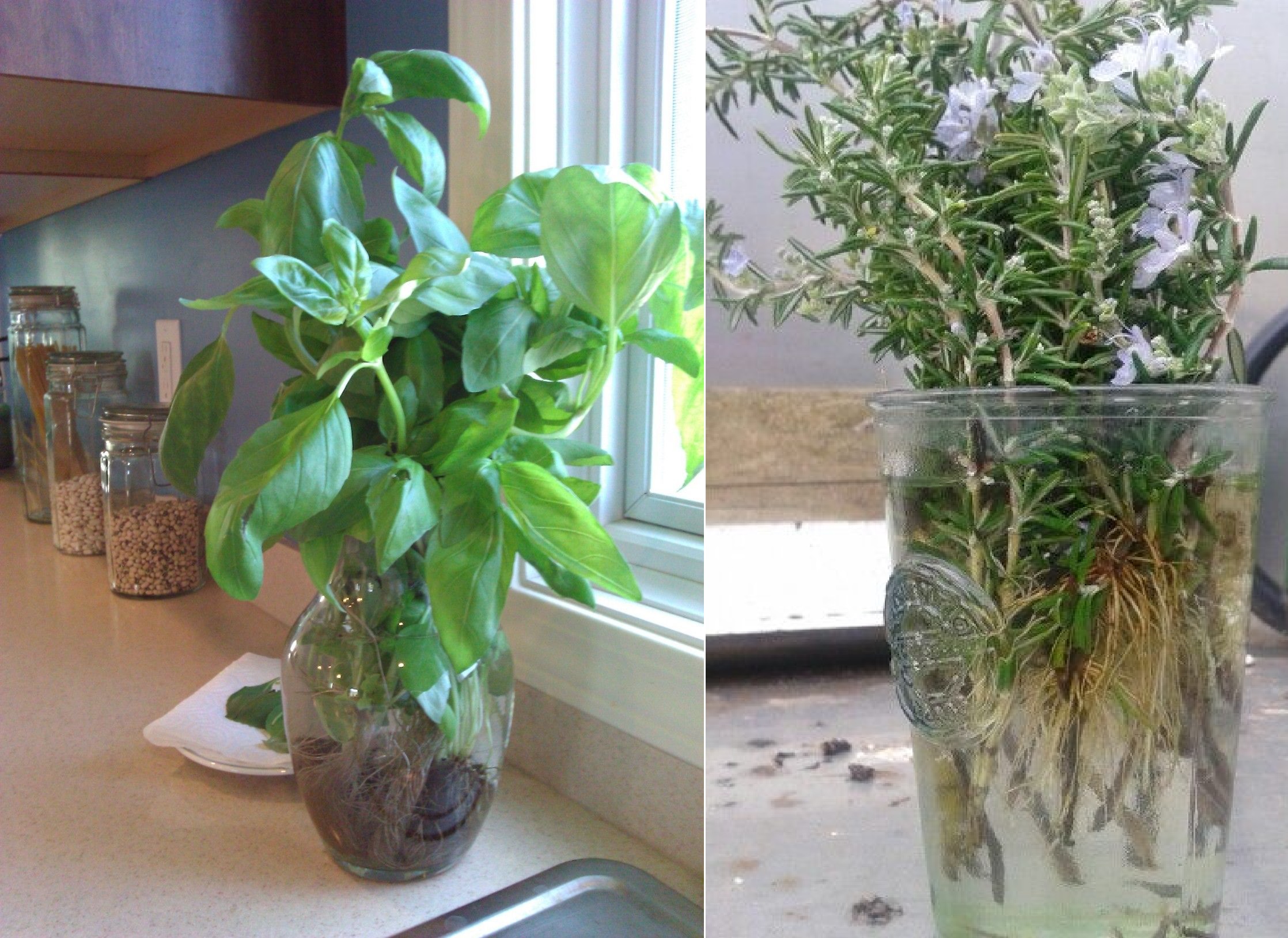Do you have a few favorite herbs? Why not plant them in water and place them on your kitchen windowsill or countertop?
Herbs grown in the water are just as fragrant as those grown in the garden. You don’t have to mess up the soil or worry about regular watering or seasonal changes.
Most herbs like to grow in water, but herbs that are propagated by cuttings are easier to grow in water.
Annuals grown from seeds such as cilantro, mustard, and dill are a little trickier because you have to sow the seeds in soil or another medium and then transfer the seedlings to water.
The transition from soil to water is not impossible, but it may not always work because soil-grown roots are somewhat different than aquatic roots.
What You Need to Grow Herbs in Water
Water
For a simple herb stand in the kitchen, root herb cuttings in clear water in a glass jar.
Avoid using chlorinated water directly, as bleaching chemicals are not gentle on plant tissue. Both tap water left in the air overnight and stored rainwater will do.
Spring or well water is best because it contains a certain amount of dissolved minerals, which are good for plants.
Containers
Mason jars or other glass jars, or even plastic bottles, can be used as containers.
Roots generally like to grow out of light, so colored bottles, especially amber ones (like this one) work best. You simply wrap a piece of paper around the bottle to keep the root area in the dark.
This even prevents algae from growing on container walls and root surfaces. Algae won’t affect plant growth, but it will make the bottle look messy.
Narrow-necked containers have an advantage: They support the cuttings and keep them almost upright. However, the opening of the container should not be too narrow or close off the cut.
The roots need to breathe, and the opening of the container should allow free circulation of air.
If you’re using a wide-mouth container, you can choose to cover the top with nylon or wire mesh. Push the cutting into the hole, this gives the cutting some support.
Another benefit, especially in warmer climates, is that the mesh prevents mosquitoes from laying eggs and breeding in the water.
Plant cuttings
Soft cuttings root quickly in water. You don’t have to use rooting hormones. When growing herbs in the garden, cut off a 15cm section from the growing tip and place it in a container filled with water.
The best thing about growing herbs from cuttings is that you can use herbs from the supermarket. Just wash them with clean water and cut off the bottom.
Remove the lower leaves from the cuttings and snip off the lower tips of the nodes near the rooting nodes. The leaves should not touch the water when placed in the bottle. They are prone to rotting and destroying water, like a vase.
Woody cuttings such as rosemary may take longer to root. So be patient. Change the water once a week without affecting the cuttings. Once the roots start to grow (usually 2 to 6 weeks), water changes may no longer be necessary.
If you have willows in your garden, you can soak some branches in warm water overnight to create a natural mixture of root hormones. Put cuttings in a dip to encourage rooting. Alternatively, rooting hormone powder can be used.
10 Best Herbs to Grow In Water
1. Peppermint
This is the most popular medicinal mint because it contains a large amount of the volatile compound menthol. It imparts a unique cooling sensation to the skin or tongue without actually causing temperature fluctuations.
2. Spearmint
This is another mint variety closely related to peppermint. In fact, peppermint is a natural blend of spearmint and watermint, commonly known as watermint.
3. Oregano

Growing this pungent herb indoors is worth it because you can use the leaves to flavor almost any vegetable.
4. Basil

Basil will love the warmth of your kitchen and will happily grow in water-filled containers as long as it is provided with good light.
5. Sage
In spring, take soft cuttings and root them in water. You’ll probably only need a sprig or two of sage, since only a small amount is needed to impart flavor. Place the plant in a bright, well-ventilated area, as this herb is prone to powdery mildew.
6. Stevia
This sweet botanical is a great addition to freshly brewed teas and beverages at home.
7. Lemon balm

The citrus scent of this mint herb is a welcome treat in any home, especially in winter. The leaves are great for making tea. Take cuttings in spring or fall. Place the container in a warm location with plenty of bright indirect light. Root formation may take up to 3-4 weeks. Change the water regularly to keep the water clean.
8. Tarragon
Cuttings are made after new shoots appear in spring. Fall cuttings are also good, but may take longer to root. Place the cuttings in a warm and well-lit location. French tarragon is best used as a culinary herb. Russian tarragon has a milder, even milder flavor, so use it as a side salad.
9. Thyme

You will need to remove the green cuttings from the new growth. Older trees that have become stiff and brown may not be able to take root easily. The best time to harvest cuttings is mid-spring to early summer, before the plants begin to bloom. Thin thyme stalks dry out quickly. Therefore, it should be put into water immediately after cutting. Spray above the water surface if necessary. Once it begins to grow, cut off the stems to encourage branching.
10. Rosemary

Semi-lignified rosemary cuttings require longer roots to form, but new shoots from spring cuttings can form more quickly. Regardless, the effort is well worth it, as rosemary is an ideal houseplant for sunny locations.
